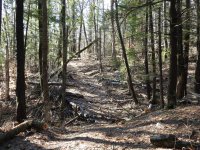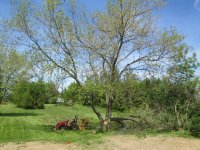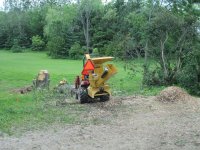Bullwinkle123
Platinum Member
Greetings all, hope you're faring well in your coronavirus self-isolation.
So I've finally purchased a tractor (it hasn't been delivered yet). And while I was planning to put this off for a while, I'm very interested in getting a chipper/shredder and I'm trying to understand how many misconceptions I'm operating with along the lines of what I can put into it, and what I get out of it. I've read a number of threads here on the subject but didn't quite get out of them what I was looking for. I understand the basics, sharp blades on chippers, hammer-like things on the shredders. Dry wood (as opposed to green wood) might heat carbon treated knives and cause them to lose their ability to hold their edge, perhaps, I'm not sure.
So here are my various misconceptions / hopes for you to dash to the ground. Let's assume I'm talking about a combo thing like a Wallenstein *42 series chipper/shredder, though that may be too rich for my blood. I'm wondering about something used, or cheaper, but we'll see, plenty of other threads for that topic.
So is any of the above true? And can I clean up the a lot of this mess that has been accumulating in my forest if I want extra chips/mulch sooner than, say, just waiting for branches from recent falls or logging? There are lots of parts of my forest that look like this the following picture.

That picture isn't representative of what I'd likely go for, it's just to give some mental clues about the New England forest. I have lots of fir, white pine, maple, birch, beech, cherry, hemlock, ash, aspen and some oak. I wouldn't chip stuff rotting on the ground, but the branches and trees "in the air" may be a bit punky, *if* they would be any kind of decent mulch/compost. Question is whether punky wood is useful.
I'd definitely be happy if I could make my mulch instead of paying to bring it in. Note that I'd save any money with a Wallenstein, but it appeals to my "locally sourced and recycled material" ethic. Right now I buy about 8 yards of mulch a year, and that doesn't even cover half the things I'd like to mulch. I'm also trying to improve my compost game, but I can't quite seem to achieve "cooking pile liftoff" because I just don't have the bulk. I'm hoping the shredder might help me with that. Of course the tractor might help too, it'll be a lot easier to stir the pile using the tractor than my back and a hand tool, I hope.
I'm pretty comfortable sharpening my various tools, I'm not sure how much I'd have to step up my game to sharpen a chipper/shredder. Roughly how often would I have to do that?
Thanks for any advice.
So I've finally purchased a tractor (it hasn't been delivered yet). And while I was planning to put this off for a while, I'm very interested in getting a chipper/shredder and I'm trying to understand how many misconceptions I'm operating with along the lines of what I can put into it, and what I get out of it. I've read a number of threads here on the subject but didn't quite get out of them what I was looking for. I understand the basics, sharp blades on chippers, hammer-like things on the shredders. Dry wood (as opposed to green wood) might heat carbon treated knives and cause them to lose their ability to hold their edge, perhaps, I'm not sure.
So here are my various misconceptions / hopes for you to dash to the ground. Let's assume I'm talking about a combo thing like a Wallenstein *42 series chipper/shredder, though that may be too rich for my blood. I'm wondering about something used, or cheaper, but we'll see, plenty of other threads for that topic.
- Recently fallen trees: their branches will make excellent compost additions when fed through the shredder.
- Recently fallen trees: bigger pieces wll go through the chipper, making good chip mulch for gardens, trees, etc.
- My forest is a mess. I'd like to chip up some of the years' old trees as well. It's all dry wood, though some of it may be closer to rotting and certainly soaked in the spring. See attached picture later. Most of this fallen stuff is pine, I won't feel bad if I have to pass on chipping harder (dry) woods like maple, I suppose. I have a lot of brush piles of small-ish dried branches I'd like to chip/shred, as they are unsightly and taller than I am.
- I can use the chips/mulch immediately likely without too much impact for lack of nitrogen fixing, but if I let it sit in a pile to cook for a year or two that is even better.
So is any of the above true? And can I clean up the a lot of this mess that has been accumulating in my forest if I want extra chips/mulch sooner than, say, just waiting for branches from recent falls or logging? There are lots of parts of my forest that look like this the following picture.

That picture isn't representative of what I'd likely go for, it's just to give some mental clues about the New England forest. I have lots of fir, white pine, maple, birch, beech, cherry, hemlock, ash, aspen and some oak. I wouldn't chip stuff rotting on the ground, but the branches and trees "in the air" may be a bit punky, *if* they would be any kind of decent mulch/compost. Question is whether punky wood is useful.
I'd definitely be happy if I could make my mulch instead of paying to bring it in. Note that I'd save any money with a Wallenstein, but it appeals to my "locally sourced and recycled material" ethic. Right now I buy about 8 yards of mulch a year, and that doesn't even cover half the things I'd like to mulch. I'm also trying to improve my compost game, but I can't quite seem to achieve "cooking pile liftoff" because I just don't have the bulk. I'm hoping the shredder might help me with that. Of course the tractor might help too, it'll be a lot easier to stir the pile using the tractor than my back and a hand tool, I hope.
I'm pretty comfortable sharpening my various tools, I'm not sure how much I'd have to step up my game to sharpen a chipper/shredder. Roughly how often would I have to do that?
Thanks for any advice.
Last edited:







